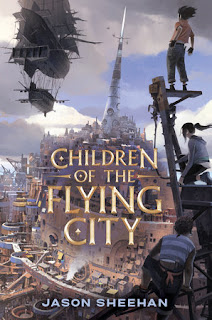
He applied the Page 69 Test to Children of the Flying City, his first book for young readers, and reported the following:
From page 69:Follow Jason Sheehan on Twitter.When the wall curved in a direction she didn't want to go, Dagda ducked her head, pulled her arms in tight to her sides, and slipped into the maze of crowded streets and alleys that bordered the market. She wanted so badly to feel the sun on her skin, but instead balled her hands into fists and held her sleeves over her knuckles to hide her scars. She pulled up the back of her shawl like a hood and buried her face up to her nose in the part wrapped around her neck, smelling smoke and breath and dust like memory in the loose fabric. She made herself small. Just another forgettable girl, making her way a little too quickly, a little too nimbly, out to the bright and wind-beaten blocks at the very edge of the Flying City.In this scene, Dagda--one of the books three young protagonists--is doing nothing more than walking down a street. Just going from one place to another. But I think The Page 69 Test works here because it catches her in a rare moment of quiet, lost in her own thoughts while, all around her, larger and more complicated stories are revolving.
Dagda didn't see the old man watching her. Maybe because she had her head down or maybe because her mind was on other things. He had a white mustache, wore a shirt made of a twisted white sheet, and had a long, bloody scratch down one arm. He stood casually, smiling, smoking a short, stumpy pipe and talking with a short, stumpy man.
The old man is Semyon Beli, of course. The man who boxed the carrier bird. We've met him before. The other one, though? Him, we haven't seen yet.
His name is Reyn Farrago and he's a ship's engineer. He's solid as a packed box, lumpy with muscle, dressed in a stained and patched boiler suit with his sleeves rolled to the elbows and a dirty string around his neck hung with compression screws. The skin of his arms is loud with tattoos.
Still, Dagda slid right past without noticing anything more than the sweet, sticky smell of Semyon's pipe smoke. The two men, though, took very careful stock of her.
'The girl?' asked Semyon Beli.
The engineer nodded, scratching the side of his face with nails showing black half-moons of grease. 'If that's what you want to call her, then sure. That's the girl.'
Why must she make herself small?
What's with the scars?
Who are these men and why are they paying such close attention to her?
And what does the engineer, with his dirty nails and tattoos, mean when he says, "If that's what you want to call her"?
Memory, closely-held secrets and the idea of a larger, more complicated adult world slowly intruding into the bubble of a child's personal narrative are all themes in Children Of The Flying City, and all of those elements are present here. In its thumping heart, this is an adventure story--full of small heists and huge risks, daring escapes, airships and war. It's about the lengths that friends will go to in order to protect each other when the world falls apart. So one page in which one girl walks alone couldn't possibly contain the essence of the entire book.
But this particular page tries hard. It captures a mood, a sense of looming threat, and asks questions that will echo through the entire story. There are bad things coming--for Dagda, for her friends Milo and Jules, and for everyone else in the Flying City. They're not here yet. Not on page 69.
But they're close. And getting closer every minute.
My Book, The Movie: Children of the Flying City.
Q&A with Jason Sheehan.
--Marshal Zeringue





